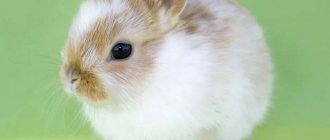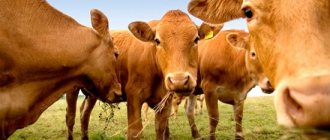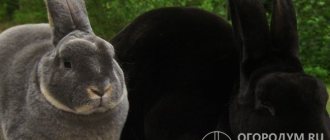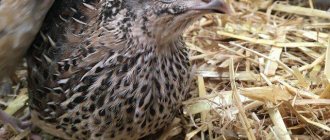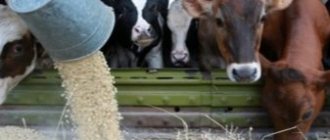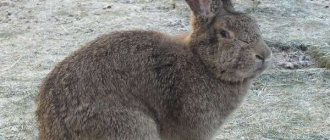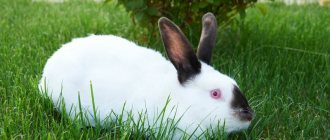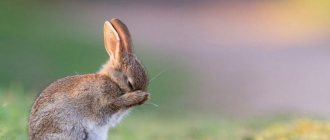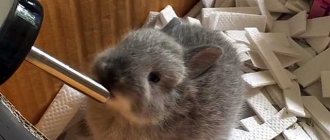How many years do decorative rabbits live at home? The lifespan of domestic fur-bearing animals depends on many factors, including belonging to a particular breed. This article will help you find out which decorative rabbits live longer and how to care for them to prolong their life.
Decorative rabbits
How long do decorative lop-eared rabbits live?
Fold rabbits have a playful nature, they are active and cute. They are loved by adults and children, because these animals easily find a common language with people and know how to show and accept tenderness. A characteristic feature of these animals is a compact, compact body, the back of which is widened, a flattened pretty face and drooping ears.
According to statistics, the average life expectancy of a rabbit with drooping ears is several years longer than that of pets with straight, erect ears. At home, with good care, they can live for about 8 years. This is the average. Some rabbits live up to 12-13 years.
How many years does a dwarf rabbit live?
Dwarf rabbit breeds are also in demand. These animals are distinguished by their good disposition, intelligence, and are trainable. Their advantage is compactness. The weight of a dwarf rabbit rarely exceeds 1.5 kilograms. Such pets can be kept even in a small apartment. Dwarf rabbits become attached to their owner and are easy to train, but their lifespan is not so long. On average, they live at home for 5-7 years, although cases of longevity have been recorded - some individuals can live up to 15 years.
What affects lifespan?
In the wild, rabbits rarely exceed the age threshold of 3 years, but domestic pets are luckier: they do not suffer from predators, eat well, and are less stressed. The lifespan of pets is influenced by various factors:
Rabbit being examined by a veterinarian
- Infections. Decorative rabbits have a very weak immune system. They can die in a matter of days from infectious diseases: myxomatosis, coccidiosis, VGBV, rhinitis and stomatitis.
- Traumatic factor. If a rabbit falls from a height, it can break its spine or damage its internal organs. It is important to ensure the safety of your pet to avoid an unfortunate death at an early age.
- Genetics. Just like human health, rabbits are affected by heredity. Healthy parents give birth to children with strong immunity. The same rule applies to animals.
- Nutrition. The diet of an eared animal must be properly balanced. A lack of nutrients, vitamins and microelements in the body always has a detrimental effect on health: vitamin deficiencies and various diseases develop, and immunity decreases.
- Hygiene. If a rabbit is kept in unsanitary conditions and neglected to clean the cage and disinfect it, there is a high probability of developing diseases.
- Stress. Decorative rabbits have a sensitive nervous system. Frightened, they may die from a broken heart. It is important to provide the animals with peace and avoid situations that could cause fear or shock. Loud sharp sounds, changes in environment, medical procedures, car trips - small animals are afraid of all this.
- Castration and sterilization. A rabbit will live several years longer if it is castrated at a young age. The same goes for female rabbits. Frequent bearing of offspring and feeding of cubs takes away the female's strength, and her body wears out faster. If you do not plan to purchase a pair for a decorative rabbit, you should think about castration.
Care and maintenance of domestic rabbits
Domestic rabbits live in special cages.
Moreover, the attribute left over from a hamster or parrot is not suitable due to its too small size. You will have to purchase a cage of appropriate dimensions for the “fluffy”. Its height must be at least 70 centimeters, and at the bottom there must be a deep tray into which the filler will be poured. The optimal temperature for keeping animals is 18-20 degrees; they do not tolerate drafts or direct sunlight very well - this should be taken into account when choosing where to place the rabbit in the apartment.
The animals are very clean, so be prepared to change their sawdust or hay at least 2 times a week. Ideally, you can clean your pet’s habitat once every 2 days.
Since in nature hares and rabbits live in burrows, domestic animals also need some kind of shelter. It is worth placing a special “house” in the cage, where the pet will hide in case of fright or just to sleep.
You will also need a container for food and a drinking bowl. Moreover, the water in it should be changed daily. Alternatively, you can use a drip device (as for rodents).
The animal must be allowed out for walks. From time to time, allow him to run around the apartment, and don’t be lazy about taking him outside for walks. It goes without saying that before doing this, buy a leash and collar so that your pet does not run away. Before releasing it into the grass, treat the “fluffy” with an anti-mite agent. This is especially true for representatives of Angora breeds. It will be extremely difficult to detect a blood-sucking animal in their thick fur.
The basis of a rabbit's diet is grass or hay. It can be soaked in lightly salted water, or sprinkled with a little flour to increase nutritional value. The digestive system of these animals works unusually quickly, so they eat at least 20 times a day. It is advisable to give rabbits apples, carrots, cabbage leaves, turnips, beets and young corn cobs from time to time. Vegetables are given raw or boiled.
To replenish the mineral reserves, the “eared animals” are fed chalk, mineral stone, or bone meal is introduced into their diet.
As you know, these little animals love to chew on something. It is sometimes useful to place tree branches (birch, linden or apple trees) in their cage so that they “remove” the bark from the wood.
Caring for decorative rabbits is not particularly difficult. These are not demanding animals that easily adapt to home conditions. Communication with a cute “fluffy” will give you a lot of positive emotions.
Signs of old age
The owner will definitely notice age-related changes occurring in the pet. Young rabbits are playful and active, unlike older ones. They show interest in new toys, run around, play pranks, and can rarely be found at rest. When old age sets in, physical activity decreases. The animal spends most of its time lying down; it is difficult to interest it in games.
Reference. The character of the animal also changes over the years: an old rabbit quickly gets irritated and becomes capricious.
The appearance of yellow plaque on the teeth is a sign of an old rabbit.
There are other signs of aging, they relate to physiological changes:
- The appearance of yellow plaque on the teeth. A one-year-old pet’s teeth are already covered with a yellowish coating, and over the years they become even darker.
- Eyes. In older rabbits, the lenses become cloudy, and the eyelids become lumpy and dark spots appear on them.
- Stomach. The skin on the abdomen of an old rabbit sags.
- Wool. In young individuals, the fur is thick and shiny, but with age its appearance deteriorates - it thins out and looks unkempt.
How to determine the age of a rabbit
Sometimes farmers or caring owners lack information. For example, it is not clear when to slaughter a rabbit or celebrate another birthday. It is unlikely that the exact age will be known. It’s difficult to tell by looking at the teeth, like a horse’s, but it’s possible. Only molars are assessed. Examining these teeth is problematic - you will need knowledge and tools, so the method is almost never used.
There are other signs that help determine the age of a rabbit. Animals up to 9 months are considered young. They are characterized by the following:
- Eyes and ears open 6–8 days after birth.
- At about 2 weeks of age, thin down is replaced by almost adult hair. The little rabbits try the grass themselves.
- At three weeks it is difficult for the animals to sit in the nest. They respond well to external stimuli, such as sounds.
- At 4–5 weeks, animals look almost like adults. The only difference is in size. They switch to a mixed diet and no longer depend on mother's milk.
- Females do not feed their offspring, as a rule, from 60 days.
- Rabbits grow up to 6–9 months. It is important to know the size and weight of a particular breed. Large varieties take longer to grow. For comparison, some photograph ornamental animals every week. For clarity and to determine the scale, place an object nearby, for example, a matchbox, a ruler.
- Puberty. As a rule, it occurs at 4–6 months. Animals explore the world around them less. Attention switches to the opposite sex. Conflicts with fellow competitors are possible.
Adults (mature) are considered pets aged from 9 months to 3–5 years. A rabbit in full bloom can be recognized more by its behavior:
- Same-sex hostility persists. This is especially true for males. Relations with the opposite sex are normal.
- An animal at this age usually either sleeps or eats. After waking up, they look cheerful, move a lot and eat.
- A healthy pet's coat is shiny.
- Clear, shiny eyes.
- Well-fed, sometimes to excess.
The remaining animals are classified as old. They reach old age after 3–5 years.
Most of the listed characteristics of domestic rabbits can be applied to their wild relatives. They only make adjustments for living conditions and take into account human intervention.
How to extend lifespan?
For a rabbit to live a long life, it is important to show it love and care. When purchasing a baby rabbit, it is worth asking about its pedigree, who its father and mother were, and how healthy they were. Knowing what diseases the pet is predisposed to, the owner will be able to pay attention to prevention, working in the right direction.
You can protect your animal from diseases if you vaccinate on time. Vaccinations will help prevent life-threatening infections for your pet. This is especially important to do if the owner plans to walk the pet outside on a leash.
Physical activity is beneficial for a decorative rabbit. In order for the rabbit to lead an active lifestyle, you should choose a spacious cage, and place ladders, tunnels, and a wheel inside it. It’s good if the animal spends at least an hour and a half a day outside its cage, walking around the apartment, and even better - in the fresh air. These are the main rules thanks to which the decorative rabbit will be healthy and be able to live a long life. Let’s consider what else will help prolong your pet’s lifespan below.
Keeping it clean
The cage is cleaned regularly, cleared of droppings, the floor, bars and trays, drinking bowls and feeders are disinfected. The room where the pet's cage is located should not be dusty. You need to wash the floor and wipe the furniture with a damp cloth.
The cage must be perfectly clean
It is important to keep the animal’s fur clean and comb it out so that tangles do not form. This is especially important during shedding. If you do not comb the fur, the rabbit, while licking itself, will eat the hair, as a result it may die from intestinal blockage.
Attention! You cannot bathe a decorative rabbit. Partial washing of the paws and hindquarters is allowed if the pet is soiled with feces. A wet rabbit should not be released onto the floor until its fur is dry.
Conditions of detention
Rabbits are sensitive to drafts and dampness . When an animal is in such conditions, its immunity decreases. A cold can lead to the death of an animal. Rabbits also do not do well in hot and stuffy rooms. The cage should not be located on the windowsill so that the pet does not suffer from drafts and overheating in the sun.
Nutrition
In addition to feed, the animal’s diet includes good quality hay, vegetables, herbs, and tree branches. In winter, it is worth strengthening his immunity with vitamin and mineral supplements. You can't feed a rabbit:
- sausages;
- meat;
- sweets and pastries;
- wet grass;
- poisonous plants;
- moldy hay;
- rotten vegetables.
Attention! Acquaintance with new products is carried out gradually.
Safety
It is recommended to install the pet's cage on a hill, that is, on a cabinet or table. It is important to ensure that the door is securely fixed so that the rabbit cannot open it itself and fall down. It is unacceptable to drop the animal or step on it: it may die from injuries.
The rabbit's place must be safe.
Protection from stressful situations
Do not expose your rabbit to stress. It is better to protect it from collisions with other pets that may frighten the animal. You should not shout loudly in the presence of a decorative rabbit, or use a drill or vacuum cleaner.
Treatment
If your rabbit is sick, you should immediately contact a veterinarian rather than try to cure it yourself. Some diseases develop rapidly and can kill an animal very quickly. Do not neglect routine vaccination.
How long a decorative rabbit will live at home depends in most cases on its owner and on what living conditions he provides for the animal. When purchasing an animal, you need to be ready to give it love and care, spend time and money on treatment, play and walk with the rabbit. Then he will live a long life.
What does life expectancy depend on?
The lifespan of domestic rabbits primarily depends on their housing and nutritional conditions. It is also important to monitor the pet’s health and, if any ailment occurs, promptly take it to the veterinarian.
- Heredity. Many diseases are transmitted genetically.
- Nutrition. In rabbits, the digestive system is designed in such a way that food is pushed through at the expense of newly received food. It is important not only to create a balanced diet, but also to ensure that the rabbit does not starve.
- Conditions of detention. Domestic rabbits are very sensitive to their conditions. They do not tolerate temperature changes, high humidity, dampness and drafts.
- Lifestyle. It is important to keep your pet active and not limit its movements.
- Diseases. Rabbits, like any other animal, can get sick. They cannot tolerate drafts and can easily catch a cold. They also suffer from parasites that affect internal organs and disrupt their functioning.
- Castration. It can significantly increase the lifespan of rabbits. It is especially significant for females, since pregnancy and caring for rabbits takes a lot of strength and energy. The more often a female rabbit gives birth, the shorter her life span.
